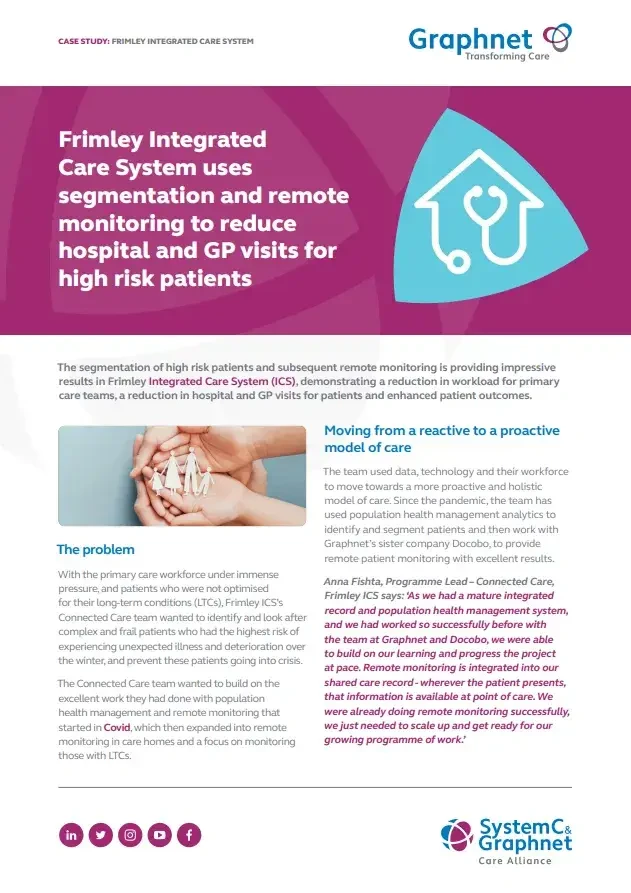What if every ICS used Remote Monitoring? Or how to save £500m a year
24 June 2025
Remote monitoring is a key tool in allowing elderly people or patients with long-term medical conditions to stay in their home and be safely monitored, but also as a way to help reduce hospital admissions and potentially save the NHS hundreds of millions.
This was shown to be the case at Frimley Health and Care Integrated Care System, where a joint project with Graphnet had a demonstrable impact on hospital admissions which, if rolled out across the UK, could help the NHS save an estimated £500m a year.
If every ICS followed Frimley’s example, population health and remote monitoring could be used to help:
- Avoid over 134,000 hospital admissions
- Free up 939,750 bed days annually, based on NHSE’s ambition to have 40-50 virtual ward beds per 100k people.
- Save around £500m for the NHS
The review of the project by Strategia found the direct savings concerning hospital attendance was in the region of £5m-£8m annually. If you extrapolated these cost savings nationally, it would be between £340.3m - £544.5m.
How Frimley’s Remote Monitoring Model Could Transform Every ICS
Frimley ICS serves roughly 800,000 people across Surrey Heath, North East Hampshire, Farnham, and East Berkshire. It enrolled over 8,000 patients onto its remote monitoring programme.
The figures for the first 3,673 patients were impressive:
- 38.6% reduction in A&E attendances
- 53.7% reduction in admissions
- 26.7% reduction in outpatient appointments
- 19.4% reduction in GP contacts
- 36.1% reduction in 999 calls
- 36.9% reduction in 111 calls
- 7.6% reduction in the volume of prescriptions issued for remotely monitored patients.
A parallel programme, which enrolled over 1,000 patients in care homes, produced similar results.
If we apply these reductions across the NHS, we would expect to see estimated reductions of:
- 10 million A&E attendances
- 9 million admissions
- 34 million outpatient appointments
Key Strategies Implemented
Frimley’s comprehensive digital health strategy – in collaboration with Graphnet Health – focused on three key areas:
1. Targeting patients with data insights
Frimley uses Graphnet’s Shared Care Records platform and Johns Hopkins ACG risk stratification to prevent avoidable admissions. They can:
- Analyse patient records across services.
- Identify people most at risk of health deterioration, like individuals with diabetes, COPD, or heart failure.
- Prioritise their support before they reach crisis point.
2. Home patient monitoring
Graphnet Health’s Remote Monitoring system enables patients to receive devices like blood pressure monitors and pulse oximeters – used to record and share health readings with clinicians through the shared care record. This allows:
- Quicker spotting of early signs of decline.
- Reductions in unnecessary A&E visits.
- Better care for care home residents and those with long-term conditions.
3. Shared Care Records for Joined-Up Care
All remote monitoring data feeds directly into Frimley’s shared care record, ensuring:
- GPs, hospital staff, community and social care teams all see the same up-to-date information.
- Decisions are made faster and safer.
- Services are coordinated more effectively.
Tackling Bed Blocking
Frimley’s approach helped reduce the average length of stay and avoided admission escalation by flagging early signs of decline remotely.
As a result, fewer patients became ‘stranded’ in hospitals, improving discharge flow and freeing up beds for those most in need. Long-term, this means:
- Supporting ongoing monitoring at home, especially for those with long-term conditions.
- Ensuring timely, data-informed care via shared records.
- Reducing the length of hospital stays and accelerating safe discharges.
Helping the NHS
- Workforce expansion and staff retention: Hiring more nurses, expanding mental health teams, and enhancing community health roles. Equally, it could allow investment in retention schemes, wellbeing initiatives, and more flexible contracts for workers.
- Strengthening primary and community care: By funding integrated neighbourhood teams (as outlined in the NHS’ Fuller Stocktake report), we can support more enhanced care home services, and expand remote monitoring (like blood pressure or oxygen checks) to high-risk groups in underserved areas.
- Reducing elective care backlogs: Increasing MRI and CT scanner availability, hiring surgical and theatre staff, and deploying referral management platforms to prioritise cases based on clinical urgency.
- Scaling digital innovation: ICS-wide adoption of NHS-assured shared care records, expand predictive risk stratification (such as using Johns Hopkins ACG or similar tools), and deliver CPD-accredited digital training for clinical and administrative staff.
- Improving urgent and emergency care resilience: Extra support to pressured A&E and ambulance services. For instance, additional Clinical Assessment Services, same-day emergency care units and hospital-at-home models. It can also enable rapid-response community crisis teams to divert Emergency Department demand.
- Preventing health inequalities: Community-based prevention programmes can be expanded to support people with long-term illnesses like diabetes, heart disease, and COPD – especially in areas where access to healthcare is limited.
How Graphnet Health can help
Through Graphnet Health, Frimley's digital-first, proactive care model demonstrates how targeted interventions, remote monitoring, and shared records can significantly ease pressures on hospitals, reduce bed blocking, and deliver better outcomes at lower costs.
With measurable outcomes and multimillion-pound savings already achieved locally, the case for scaling this model nationally is more compelling than ever.










